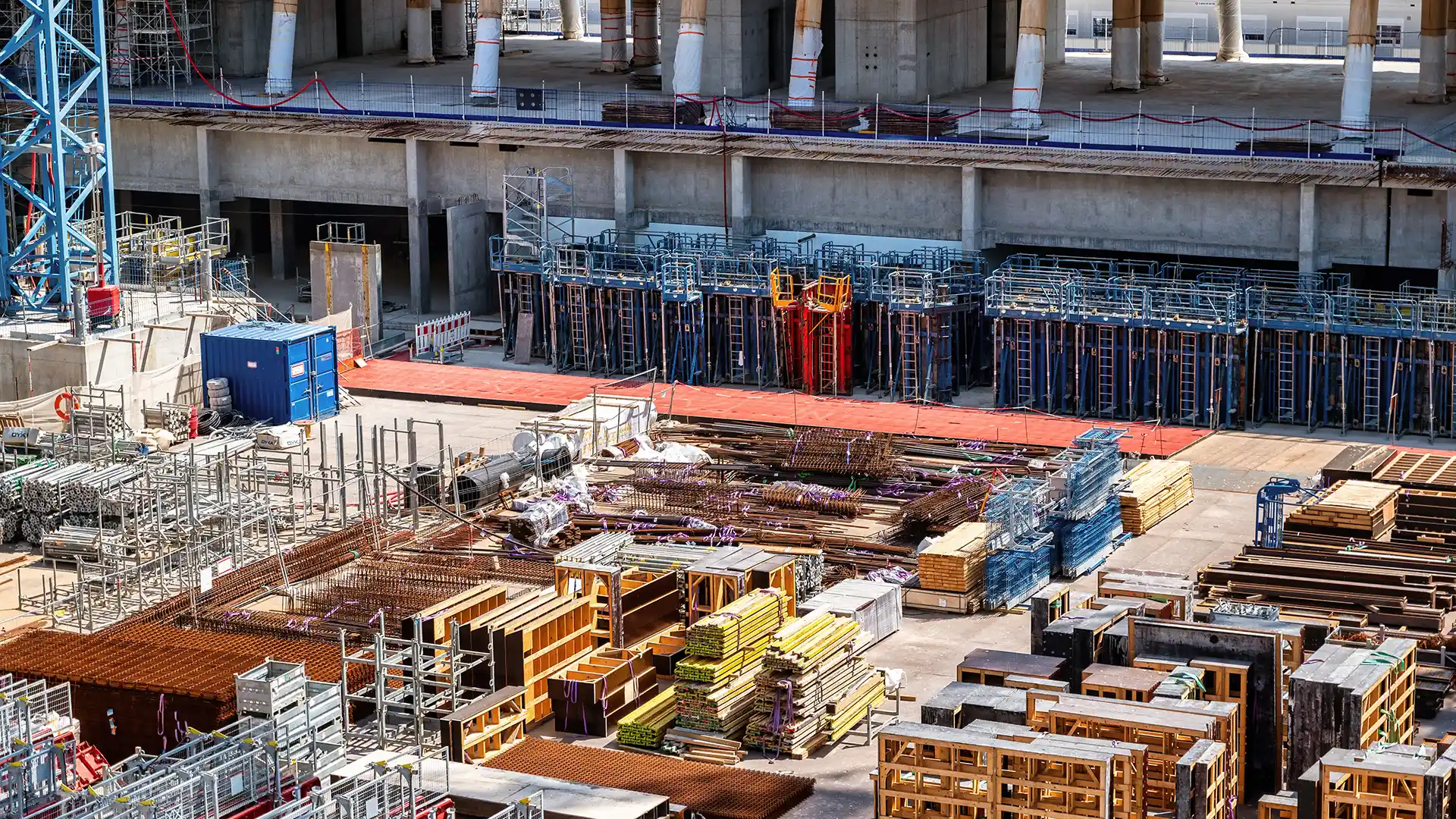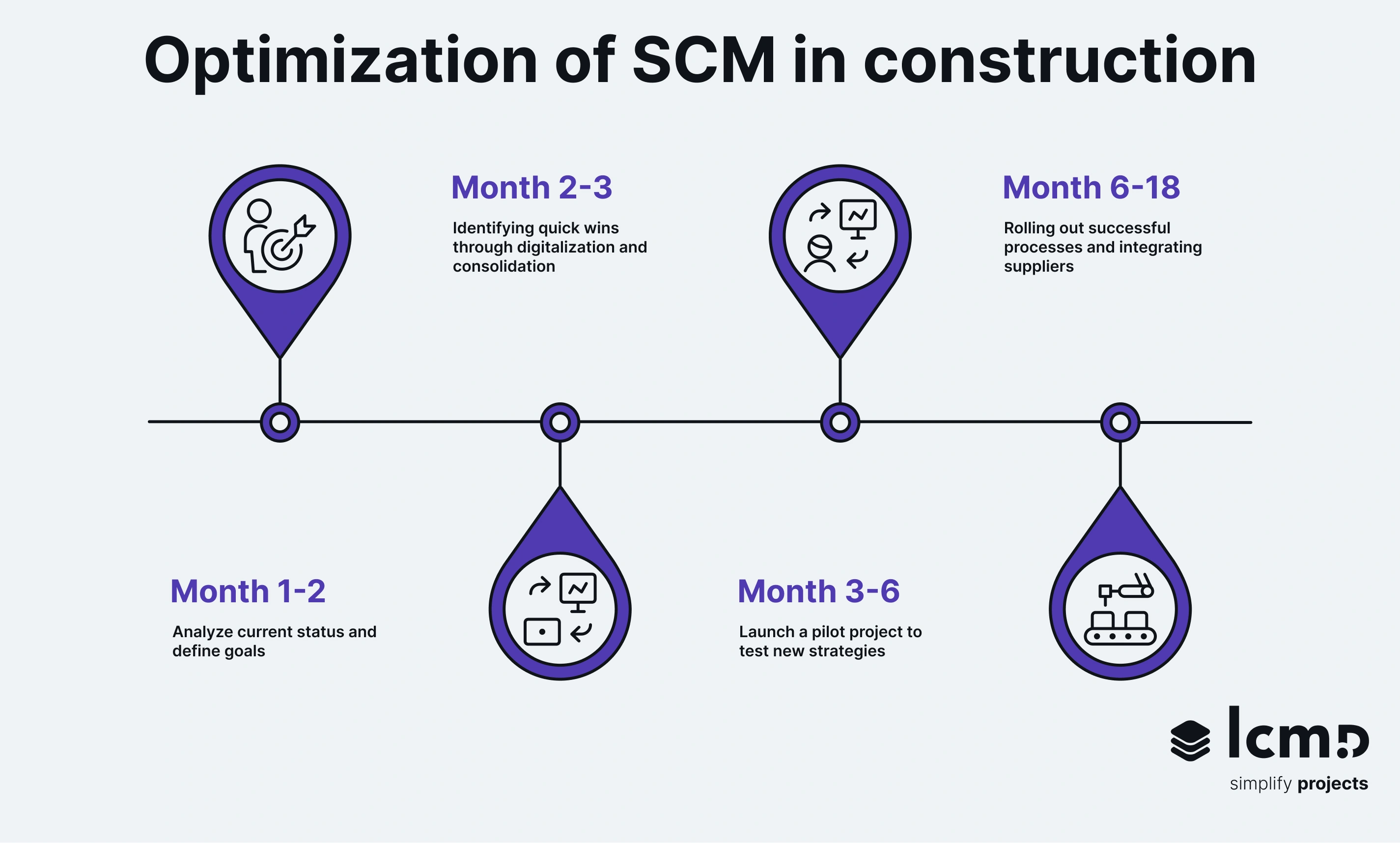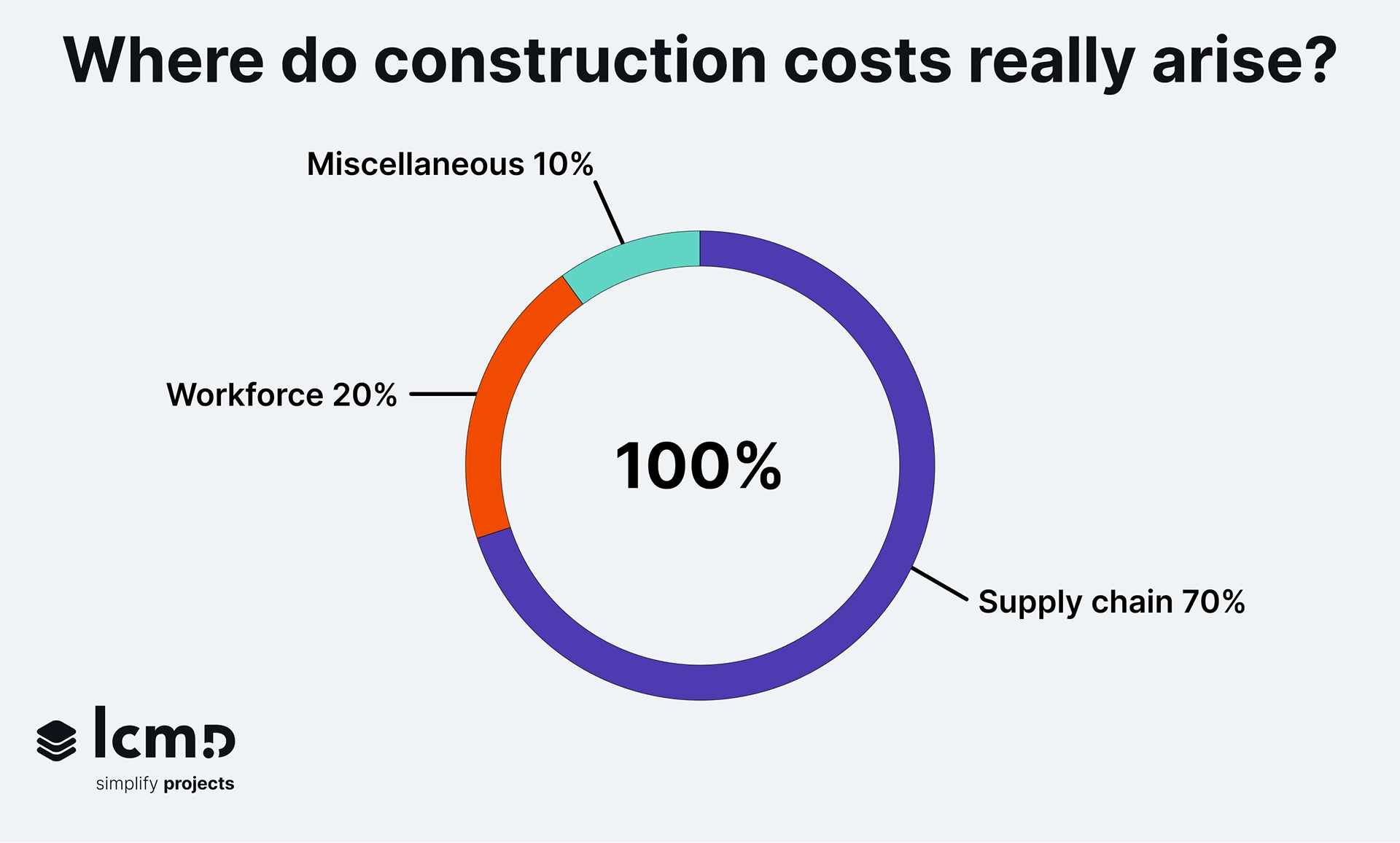Share this article:
Key Takeaways from this article
- 70% of construction costs are incurred in the supply chain – this represents the greatest optimization potential for construction supply chain management
- 10-20% cost savings and 15-30% time savings are realistically achievable through professional construction supply chain management
- BIM integration with automatic quantity take-offs revolutionizes construction material supply chain management planning and eliminates manual errors
- At least two suppliers per critical category is a fundamental rule for effective construction supply chain risk management
- Sustainable supply chain management becomes a competitive advantage due to regulatory requirements and client demands
- The four SCM roles (planner, buyer, coordinator, controller) must be clearly defined and staffed for successful implementation
- A 4-phase implementation approach – from site assessment to quick wins to scaling – is a proven implementation path
- Cloud-based, mobile supply chain software is indispensable for modern construction industry supply chain management processes
While Amazon flawlessly coordinates millions of packages, the average construction manager fails to get five suppliers to deliver on time to the job site.
This discrepancy isn't coincidental. It reveals an uncomfortable truth: supply chain management in construction industry lags decades behind other sectors. While automotive manufacturers have perfected just-in-time since the 1980s, the construction industry still operates with post-war methods.
Here's the shocking reality: 46% of all construction projects exceed their budgets – and 70% of these cost overruns occur in the supply chain, not on the job site. This means: in a €10 million project, an average of €3.2 million is lost through inefficient construction supply chain management.
But why does an industry that creates skyscrapers and bridges accept such chaotic procurement processes? More importantly: how are pioneering companies breaking this vicious cycle?
The answer lies in fundamentally rethinking what is supply chain management in construction.
Why Supply Chain Management in Construction Industry Functions Differently
Picture coordinating an orchestra with 200 musicians – except these musicians are scattered across three continents and the concert takes place on a construction site. That's exactly how supply chain management construction feels.
Construction supply chain management differs fundamentally from other industries. While BMW produces identical vehicles daily, you build unique projects. Every project is different. Every location brings new challenges.
Construction Industry-Specific Challenges
Project-based structure: Your "company" exists only for the project duration. Then it dissolves and you start over.
Weather dependency: Rain doesn't just stop work – it shifts your entire supply chain.
Space constraints: Construction sites aren't warehouses. Every square meter counts.
Complex stakeholder landscape: Architects have different priorities than subcontractors. Suppliers think in quarters, you think in construction phases.
This makes what is supply chain management in construction a unique discipline.
Digital Construction Supply Chain Management: The Future is Here
Digitalization is changing everything. Even in the conservative construction industry.
What Modern Construction Supply Chain Management Software Delivers
BIM Integration: Automatic quantity takeoffs from 3D models. No more manual calculations.
Real-time Tracking: GPS tracking for all deliveries. You always know where your materials are.
Supplier Portals: Subcontractors can order independently. Transparent and traceable.
Mobile Apps: Site managers can order and track directly from their smartphones.
Construction Management Supply Chain Software – What to Look For
Cloud-based: Work from anywhere. Construction sites rarely have perfect IT infrastructure.
Mobile First: Your teams are on the move. The software must keep up.
Industry Experience: Generic ERP systems often don't understand construction workflows.
Scalability: Does the software grow with your company?
Green Supply Chain Management in Construction Industry as Competitive Advantage
Sustainability isn't a nice-to-have anymore. It's a must-have.
Why Construction Sustainable Supply Chain Management is Gaining Importance
Regulatory Requirements: CO2 targets are getting stricter. Soon they won't be voluntary.
Clients Demand It: Public sector, investors, end customers – everyone wants sustainable construction.
Cost Savings: Efficiency and sustainability go hand in hand.
Practical Approaches for Sustainable SCM
Optimize Material Selection: Prefer recycled building materials, choose regional suppliers, use certified products.
Improve Logistics: Bundle deliveries, optimize transport routes, use alternative drives.
Promote Circular Economy: Reuse demolition materials, build modularly for future disassembly.
Supply Chain Risk Management in Construction: Be Prepared When It Matters
Risks lurk everywhere. The question isn't whether something will go wrong, but when.
Typical Risk Categories
Supplier Risks: Insolvency of key suppliers, quality problems, capacity bottlenecks.
Logistics Risks: Transport damages, traffic jams, weather-related delays, theft.
Market Risks: Price explosions for raw materials, currency fluctuations, material shortages.
Proven Risk Minimization Strategies
Diversification: Never put all eggs in one basket. At least two suppliers per critical category.
Smart Contract Design: Fixed prices where possible, escalation clauses where necessary.
Early Warning Systems: Monitor your suppliers continuously. Problems usually announce themselves.
Application of Supply Chain Management in Construction Industry: Learning from the Best
Supply Chain Management Construction Case Study: Munich Airport Terminal 2
The Challenge: 5 years construction time, 100+ trades, 300+ suppliers, millimeter-precise fitting.
The Solution Approach: Central logistics platform, 4D-BIM for precise material timing, milk-run system for small parts.
Project data:
- Total investment: 1.8 billion euros
- Logistics budget: 180 million euros (10% of the total project)
- Construction time: 5 years (2018-2023)
- Parties involved: 120 trades, 350 suppliers
- Material volume: 450,000 tons
SCM investments:
- Central logistics platform: 2.5 million euros
- 4D-BIM integration: 1.8 million euros
- Milk run system: 800,000 euros
- Tracking systems: 1.2 million euros
- Training & change management: 700,000 euros
- Total SCM investment: 7 million euros
Savings achieved:
- Savings in logistics costs: 21.6 million euros (12% of 180 million)
- Warehouse cost reduction: 15 million euros (30% less)
- Avoided delay costs: 45 million euros (due to 95% adherence to delivery dates)
- Total savings: 81.6 million euros
- ROI: 1,166% (81.6 million savings / 7 million investment)
Construction Supply Chain Management Case Study: Serial Residential Construction
The Challenge: 500 apartments in 18 months, cost pressure, parallel construction sites.
The Solution Approach: Modular construction with 80% standard components, framework contracts, just-in-sequence delivery.
Project data:
- 500 apartments in 6 construction phases
- Average apartment size: 85 m²
- Construction costs per m²: 2,800 euros
- Total investment: 119 million euros (500 × 85 m² × €2,800)
- Material costs: 71.4 million euros (60% of construction costs)
SCM investments:
- Modular construction development: €1.2 million
- Digital planning platform: 800,000 euros
- Just-in-sequence system: 600,000 euros
- Supplier integration: 400,000 euros
- Total SCM investment: 3 million euros
Absolute savings:
- Material costs: 17.8 million euros
- Logistics costs: 2.1 million euros
- Warehousing: 1.6 million euros
- Quality costs: 2.9 million euros
- Time savings (interest/overhead): 8.4 million euros
- Total savings: 32.8 million euros
- ROI: 1,093% (32.8 million savings / 3 million investment)
What You Can Learn from These Examples
Early involvement pays off: Include suppliers in planning. Their expertise is valuable.
Standardization creates efficiency: Reduce variants wherever possible.
Digitalization isn't luxury: Invest in the right technology. ROI comes faster than expected.
The Four Roles of Supply Chain Management in Construction
Your SCM team wears four hats simultaneously:
Planner: Coordinates delivery schedules with construction workflow. Sounds simple, but it's high-performance work.
Purchaser: Negotiates prices and terms. But also: builds relationships with suppliers.
Coordinator: Keeps all threads together. Communicates between all stakeholders.
Controller: Measures performance and monitors costs. No optimization without numbers.
Material Supply Chain Management in Construction Company: The Practice

Construction Materials Supply Chain Management Successfully Implemented
Demand Planning: Everything begins with precise quantity takeoffs from your construction drawings. Modern BIM systems help, but you can't do without experienced planners.
Supplier Selection: Quality, price, delivery reliability – in that order. A cheap supplier who lets you down costs more than an expensive one who delivers reliably.
Contract Negotiations: Framework contracts give you planning security. But flexibility must be included too.
Quality Control: Check upon delivery. Subsequent complaints cost time and nerves.
Construction Purchasing & Supply Chain Management: Rethinking Procurement
Strategic Procurement for Supply Chain Management Construction Company
Category Management: Think in categories. Structural steel, shell construction, fit-out – each category needs its own strategies.
Supplier Portfolio: Never put all your cards on one table. At least two suppliers per critical category.
Total Cost of Ownership: The cheapest price isn't always the best deal. Consider transport costs, quality, service.
The construction purchasing and supply chain management function is evolving from pure cost-saver to strategic partner.
Construction Industry Supply Chain Management: Your Implementation Roadmap

Phase 1: Status Assessment (Month 1-2)
Analyze Your Status Quo: Where do you stand with supply chain management in construction industry? Which processes work well? Where are the biggest problems?
Define Goals: What do you want to achieve? Which KPIs are important? How do you measure success?
Phase 2: Identify Quick Wins (Month 2-3)
Digitize Ordering Processes: No more fax and phone calls.
Consolidate Suppliers: Less is often more.
Standardize Materials: Reduce variants.
Phase 3: Start Pilot Project (Month 3-6)
Choose the Right Project: Not too small, not too big.
Test New Software: Learn what works.
Train Your Teams: Change management is crucial.
Phase 4: Scaling (Month 6-18)
Roll Out Successful Processes: What works becomes standard.
Integrate Suppliers: Digitalization only works together.
Automate Routine Work: Let software do the work.
Benefits of Supply Chain Management in Construction: The Measurable Advantages
Here's a number that gets attention: 70% of your construction costs arise in the supply chain. Optimize here by just 10%, and you save €700,000 on a €10 million project.
Cost Savings: 10-15% through better supplier negotiations and inventory optimization
Time Savings: 20-30% through coordinated deliveries and reduced downtime
Quality Improvements: Measurable through better material tracking and supplier selection
Risk Minimization: Through diversified supplier networks and contingency plans
Characteristics of Construction Supply Chain Management
Successful supply chain management and logistics in construction systems are characterized by:
- Flexibility: Adaptation to project-specific requirements
- Transparency: Complete traceability of all material flows
- Integration: Seamless connection of all project stakeholders
- Scalability: Growth with company requirements
Importance of Supply Chain Management in Construction Industry: Conclusion
The importance of supply chain management in mining construction and projects will continue to rise. Why? Projects are becoming more complex, markets more volatile, sustainability requirements stricter.
Supply chain management construction industry is no longer a side issue. It's the key to profitable projects and sustainable business success.
The numbers speak for themselves: 10-20% cost savings, 15-30% time gains, measurable quality improvements. But the path there requires system, persistence, and the right partners.

Role of Supply Chain Management in Construction at lcmd
Our project management software is specifically developed for supply chain management for construction:
- BIM Integration for automatic material planning
- Real-time Collaboration with suppliers and subcontractors
- Mobile Apps for your construction site teams
- Automated Workflows for procurement and logistics
Schedule a free consultation appointment today and discover how lcmd makes your construction projects more successful.



.svg)


.svg)
.svg)




